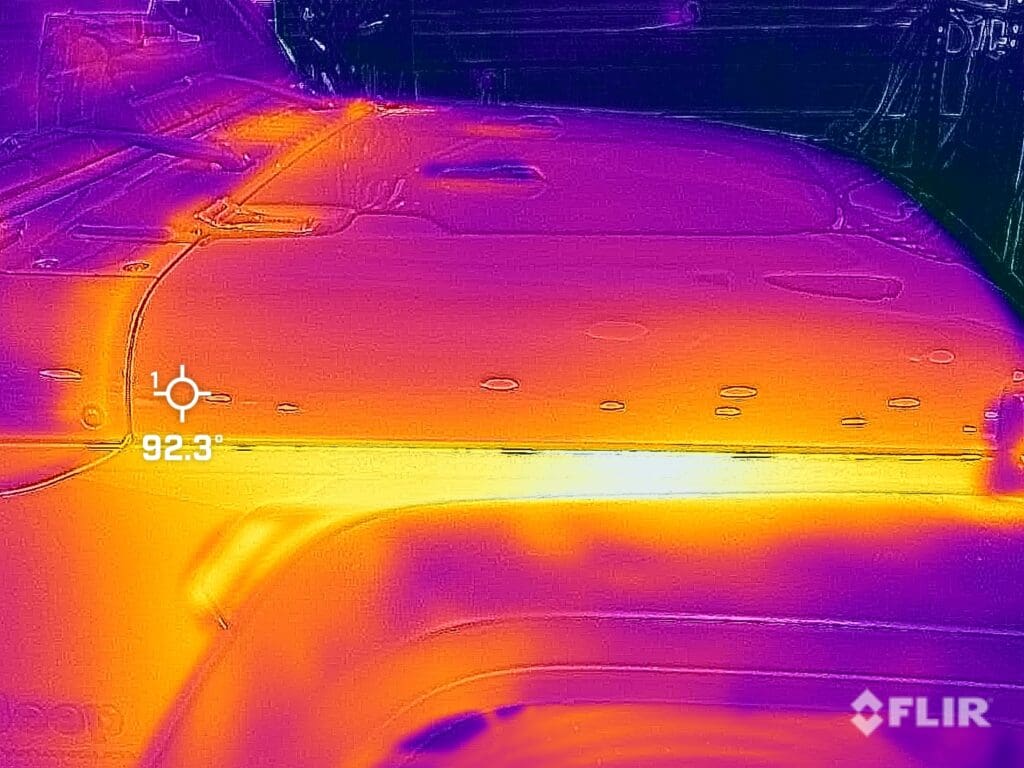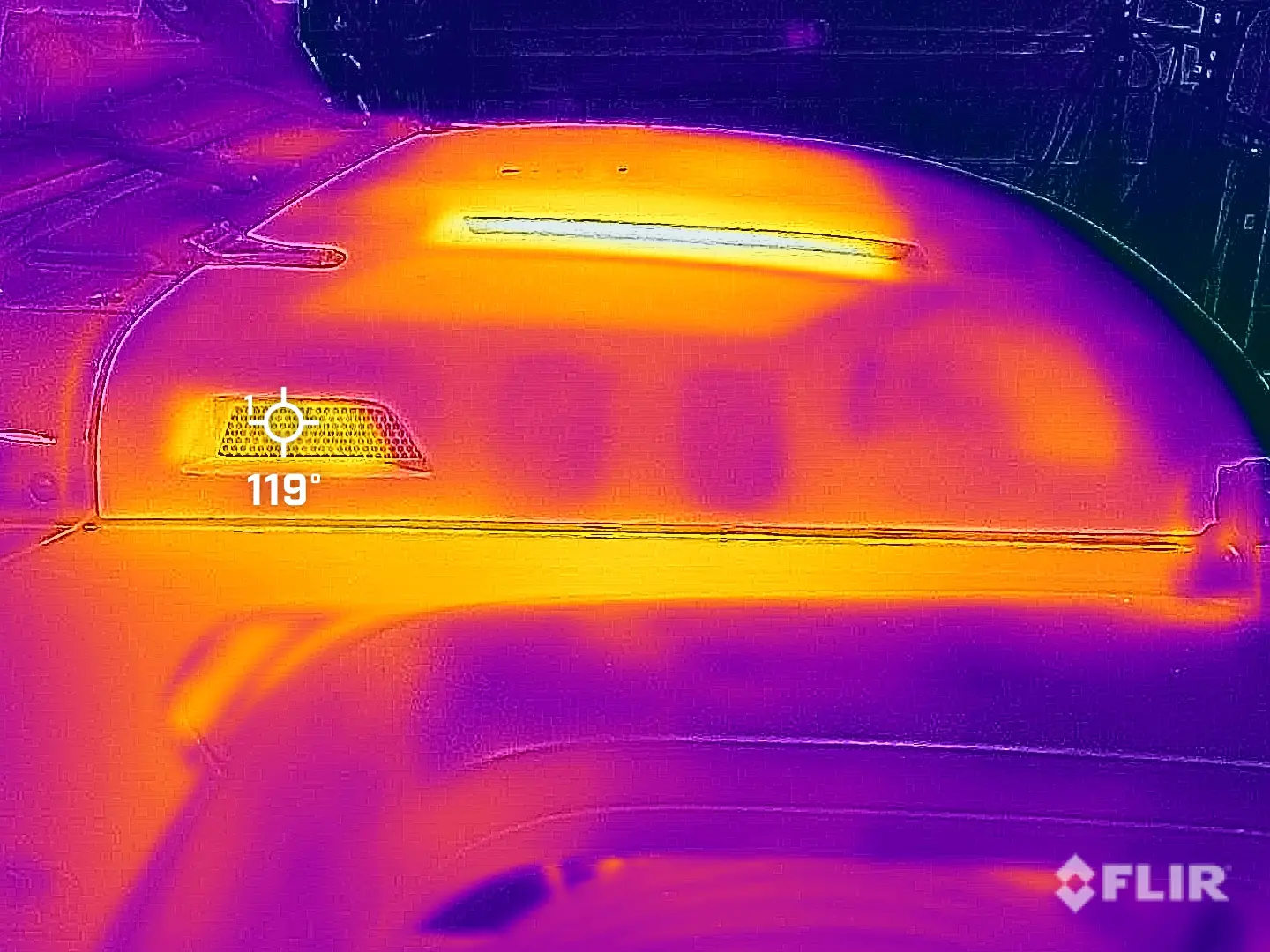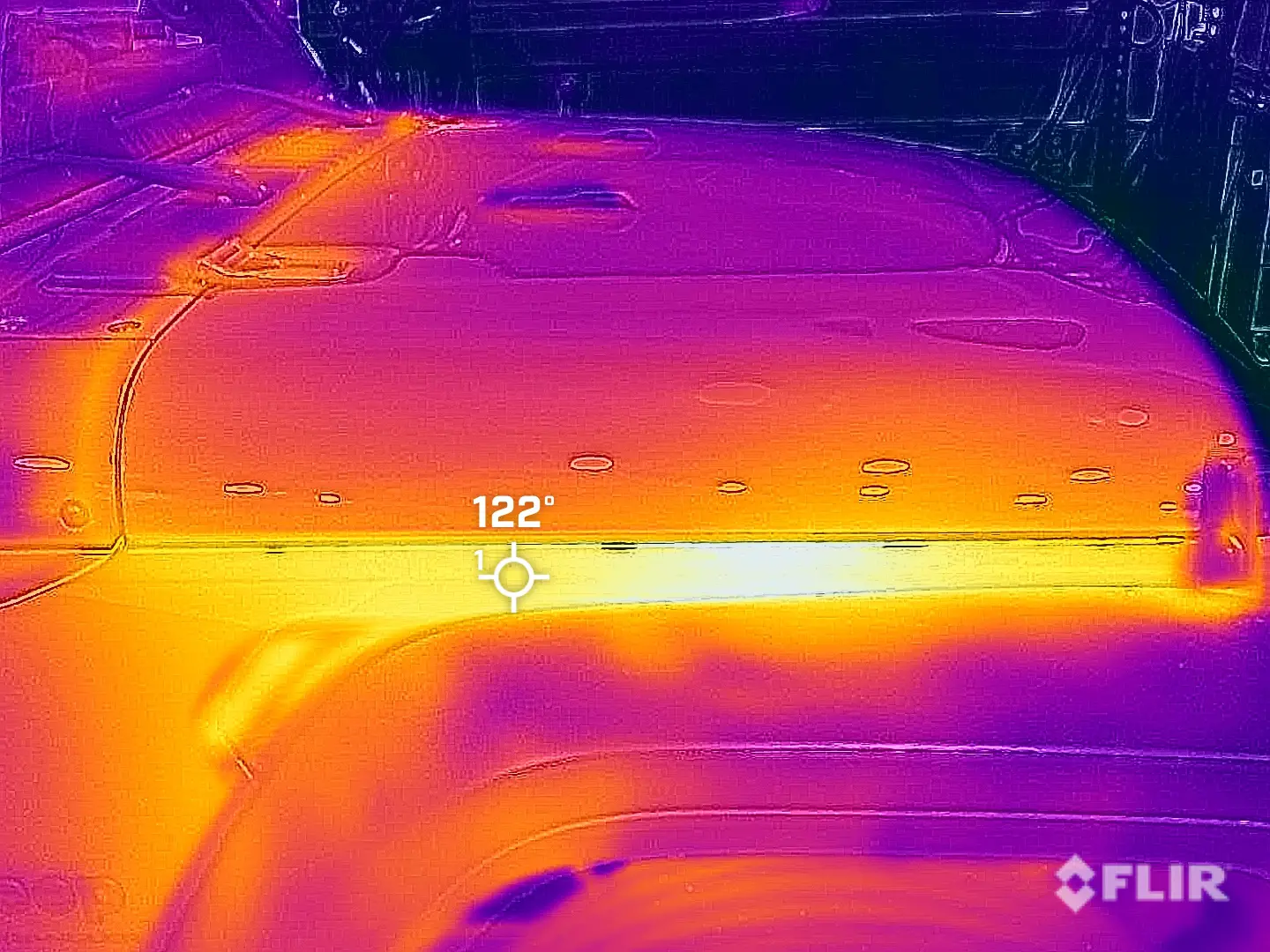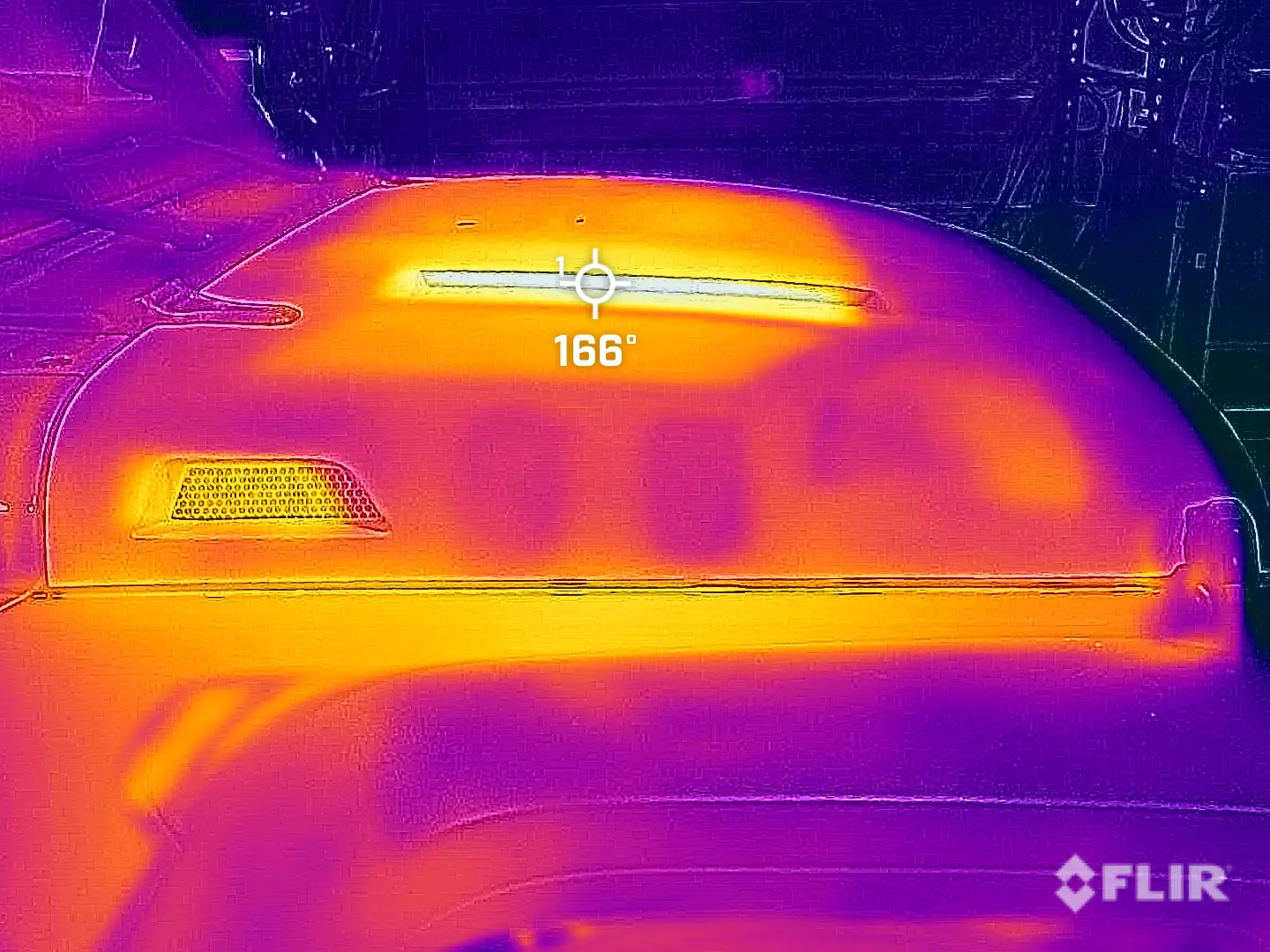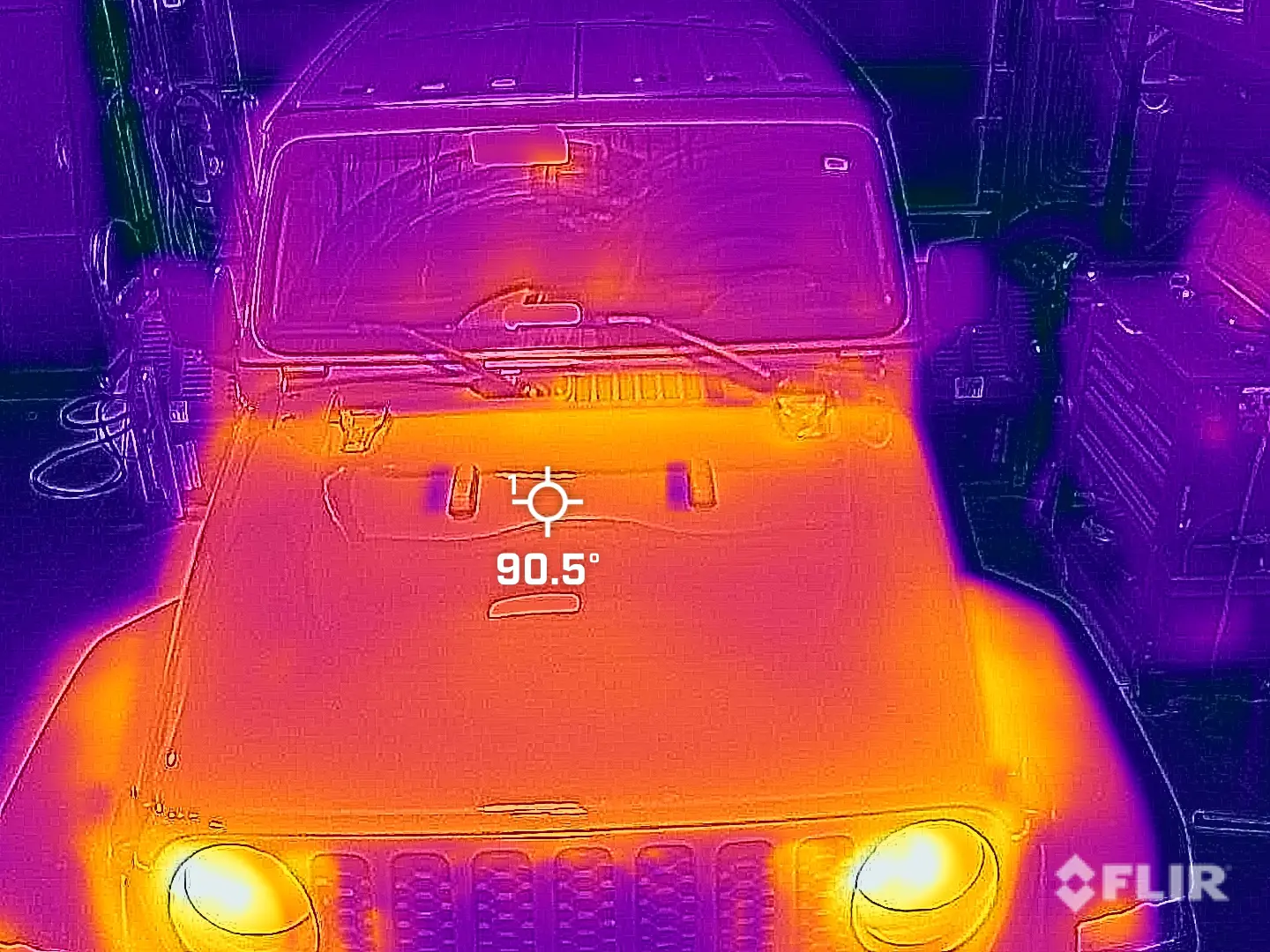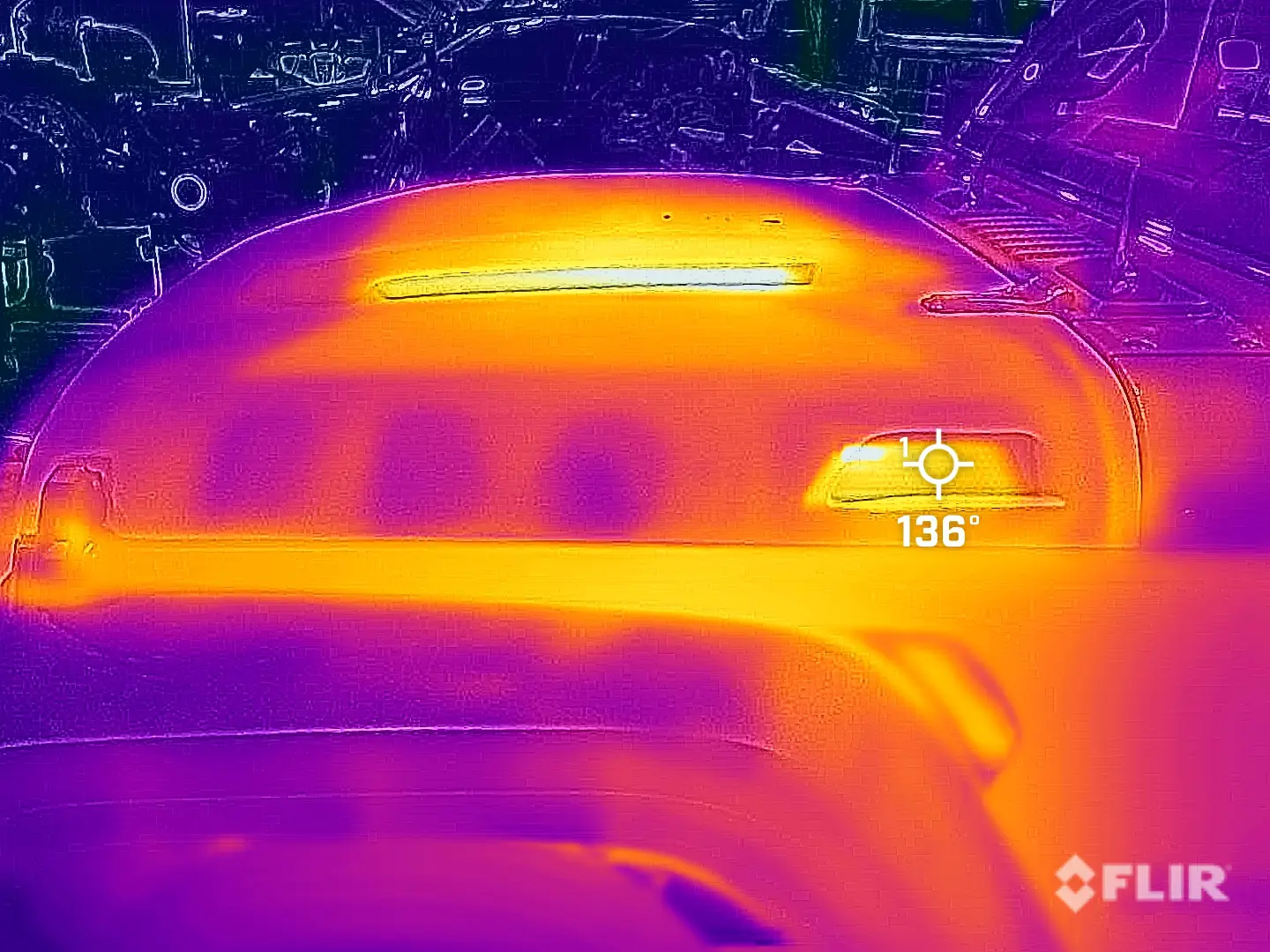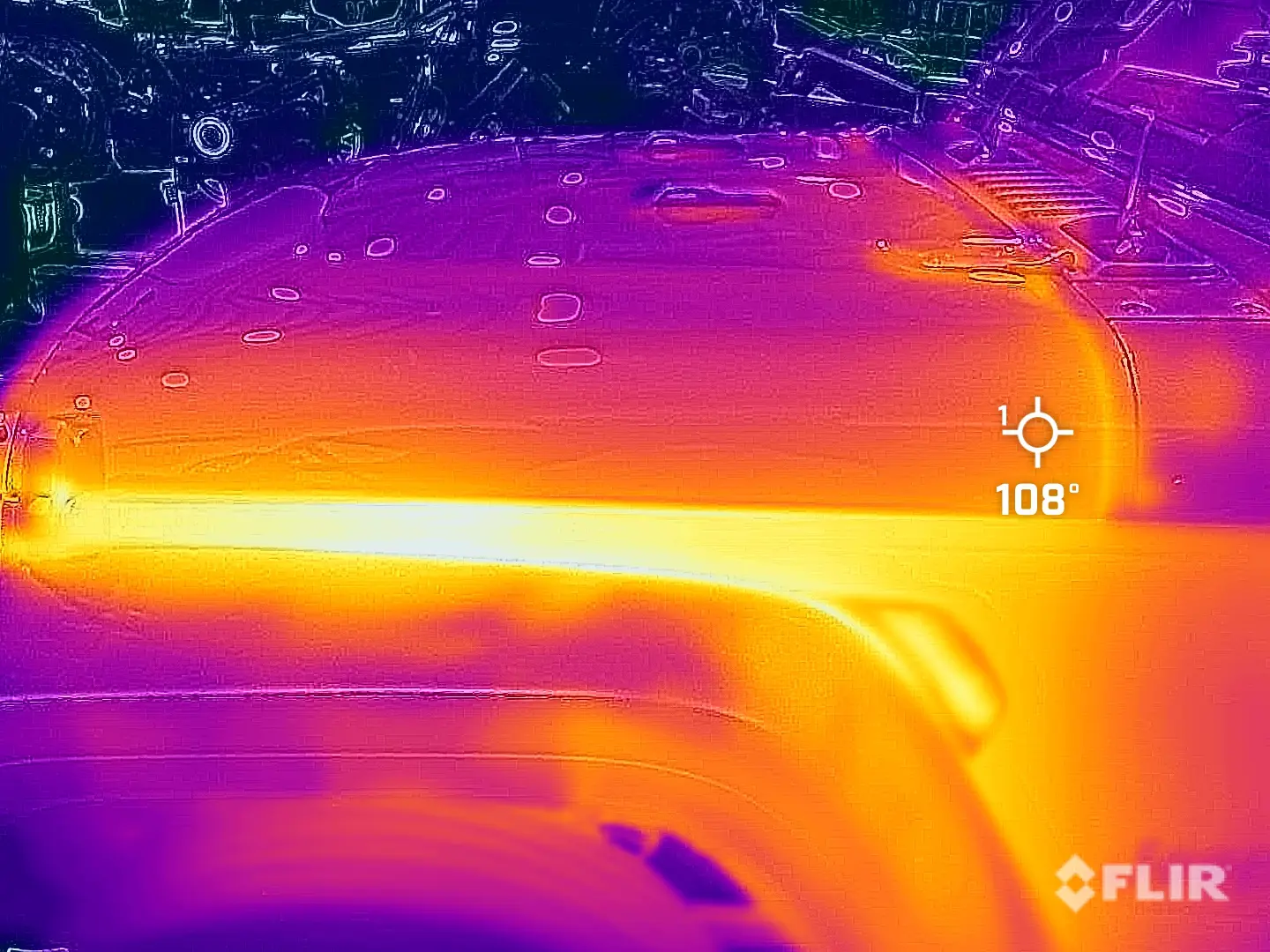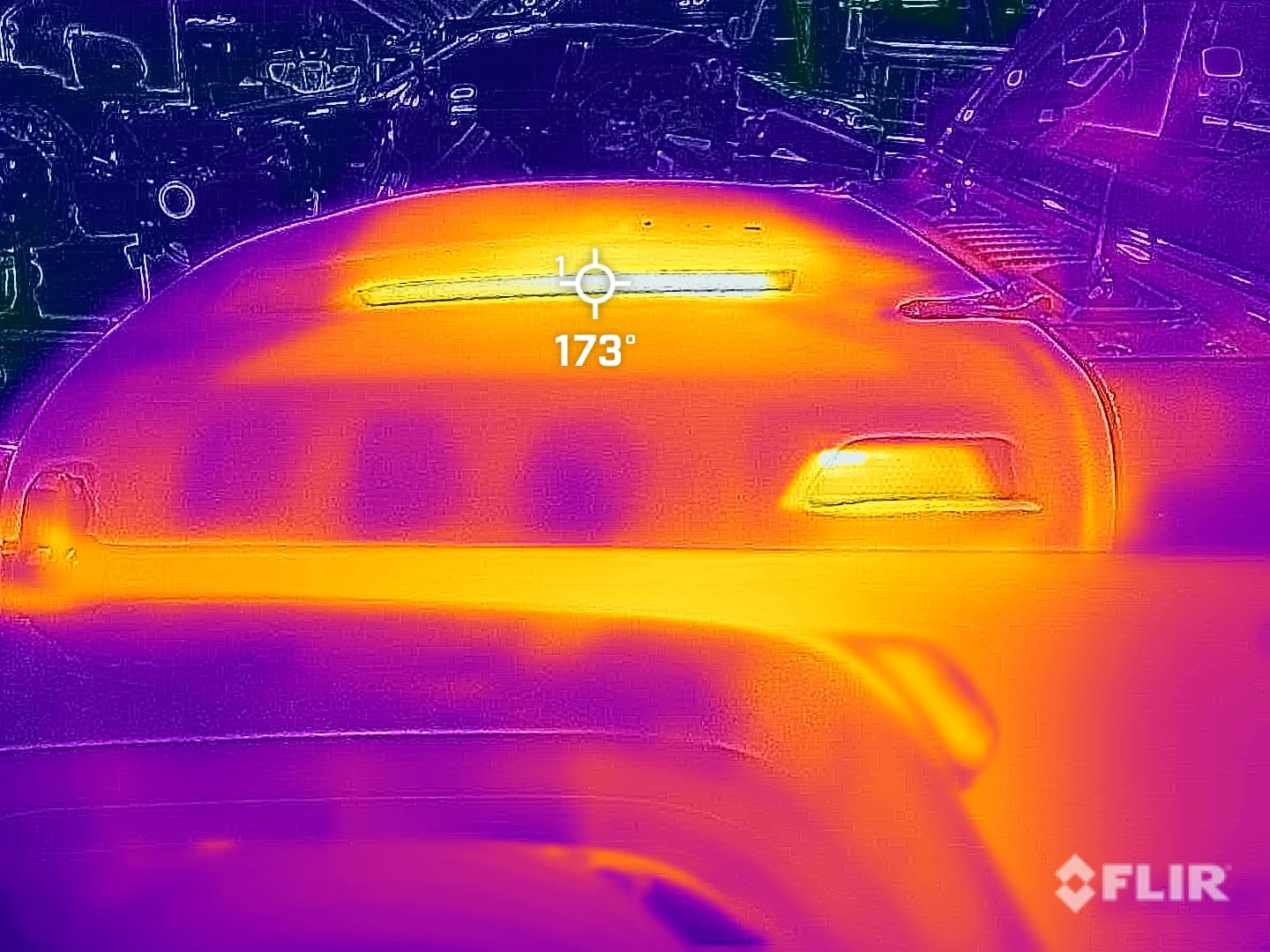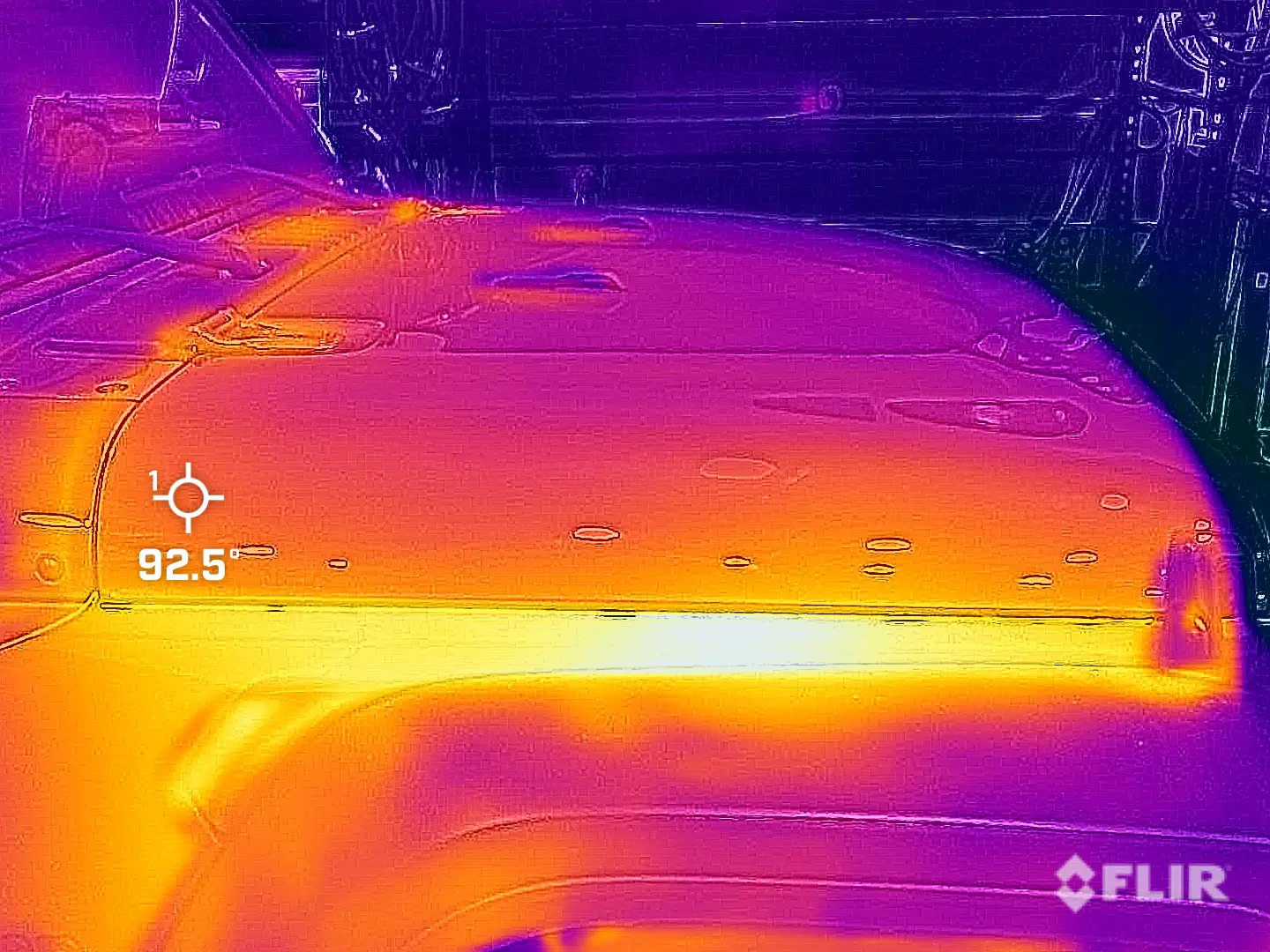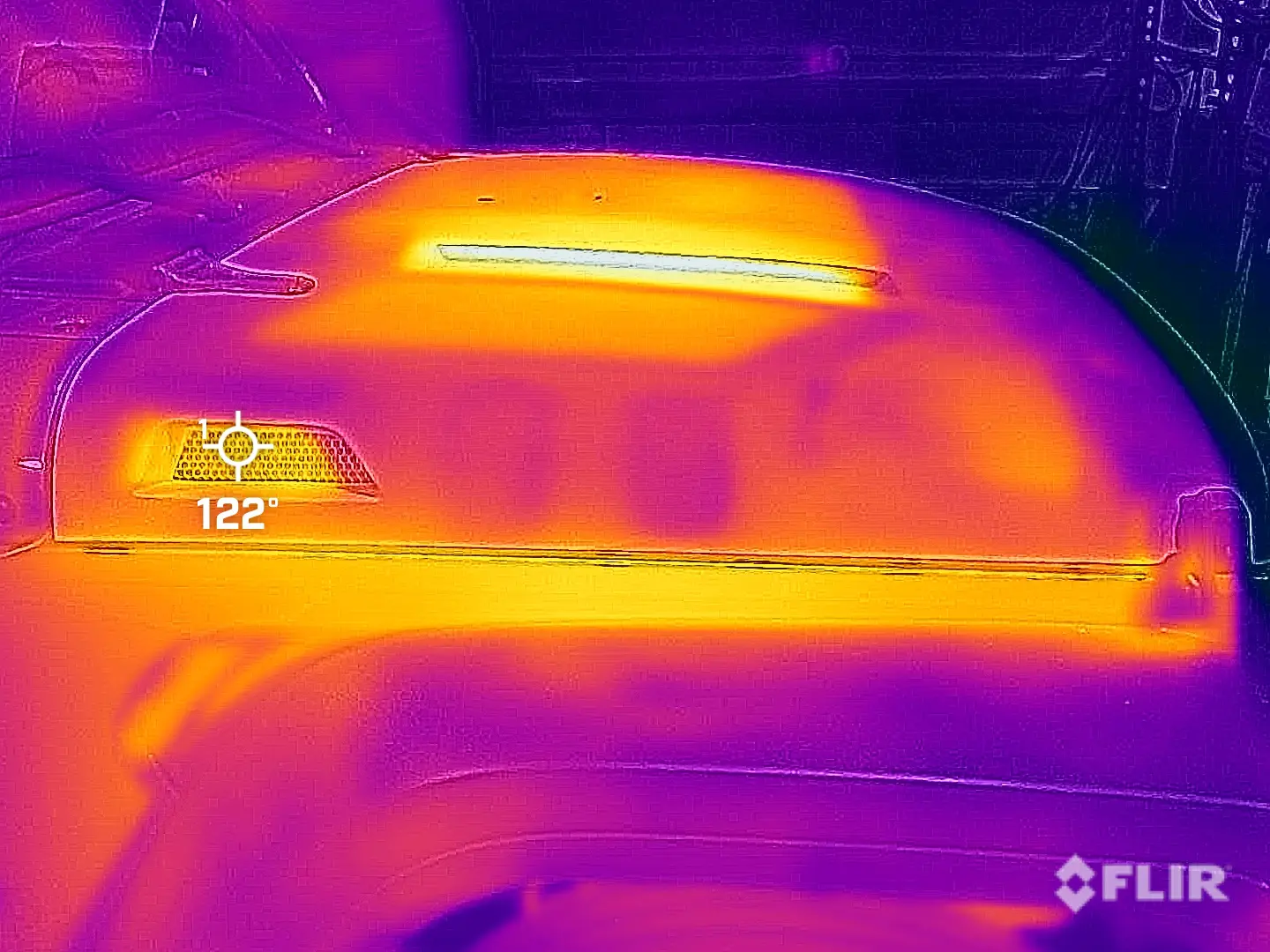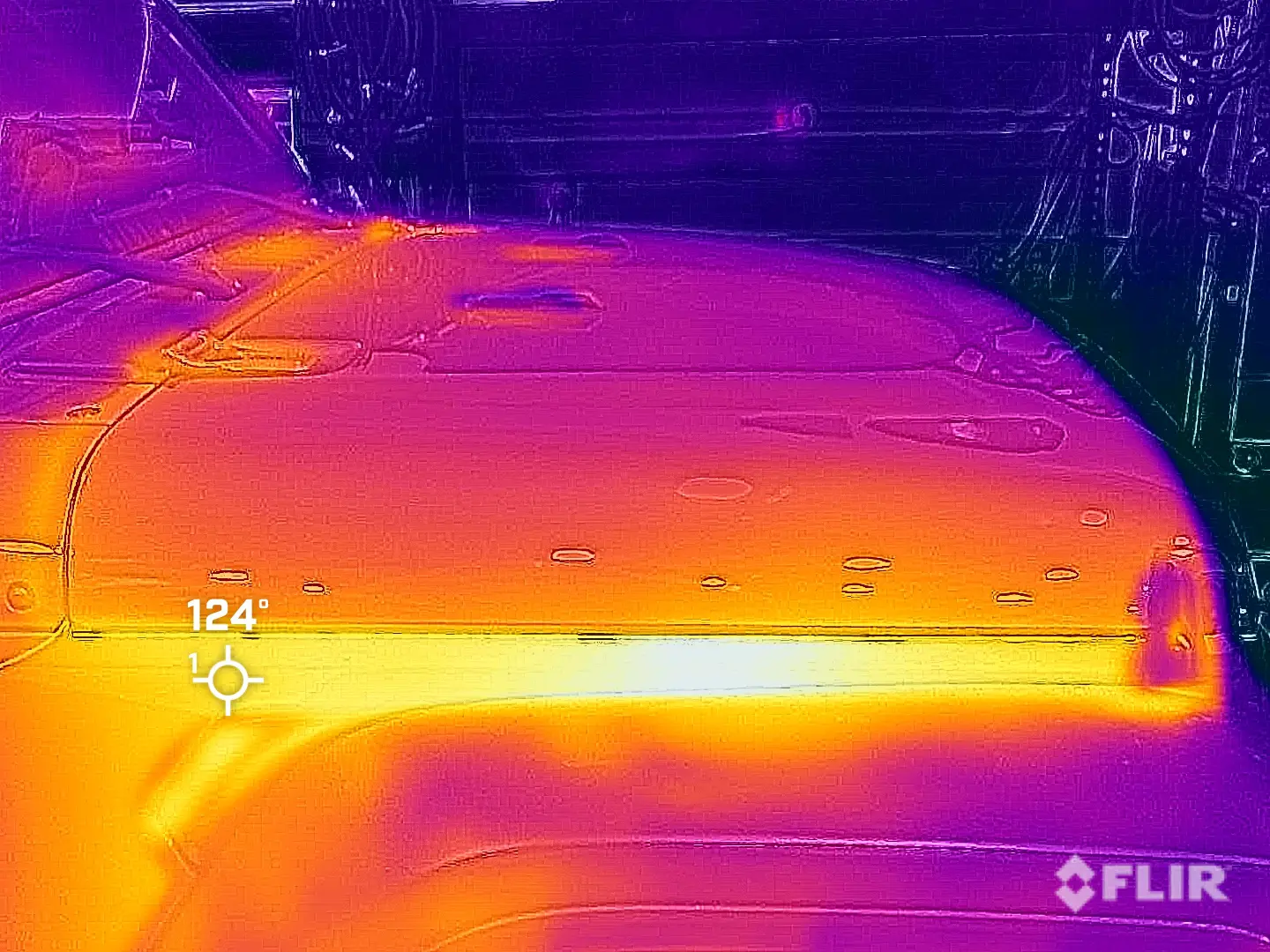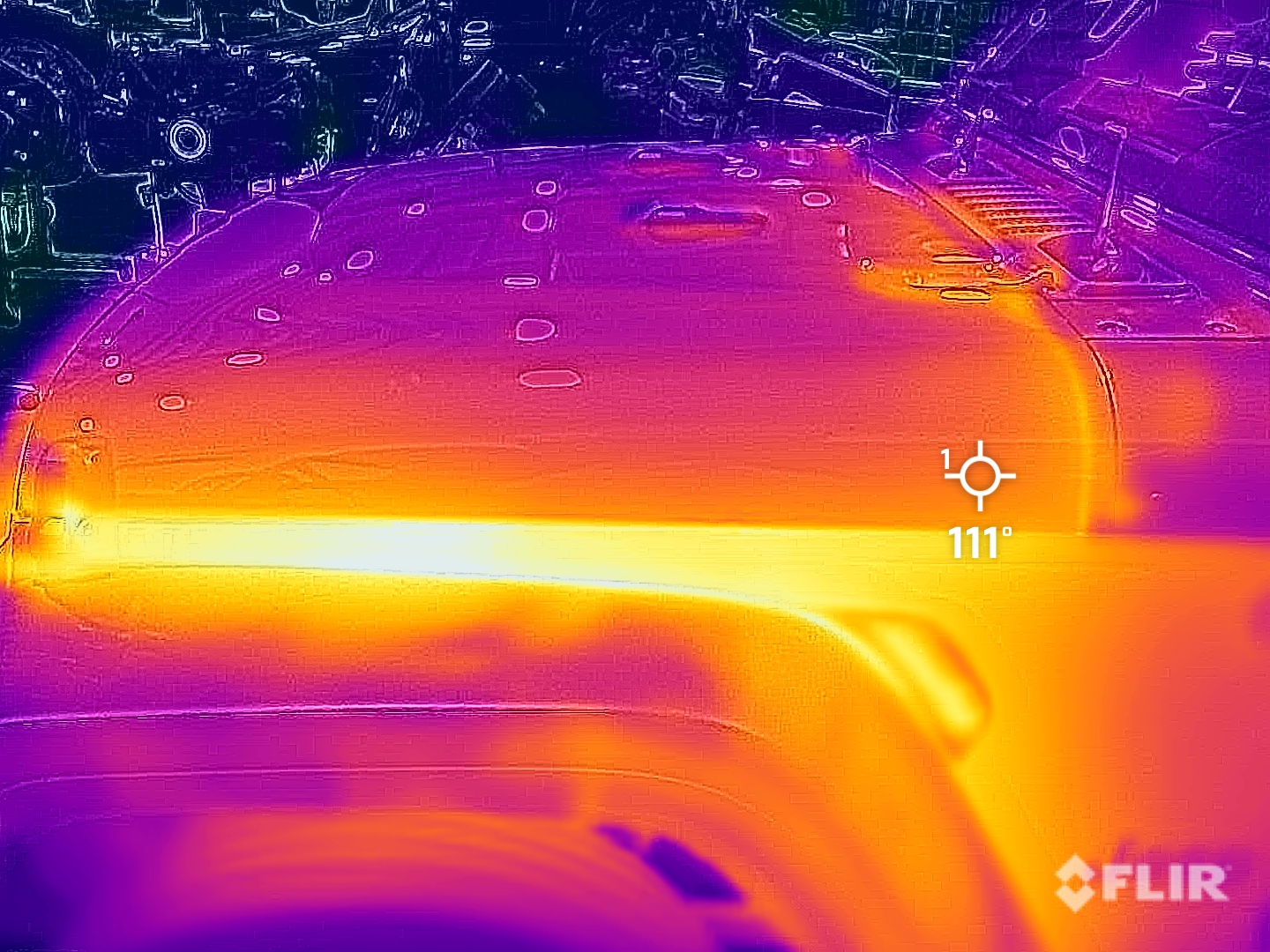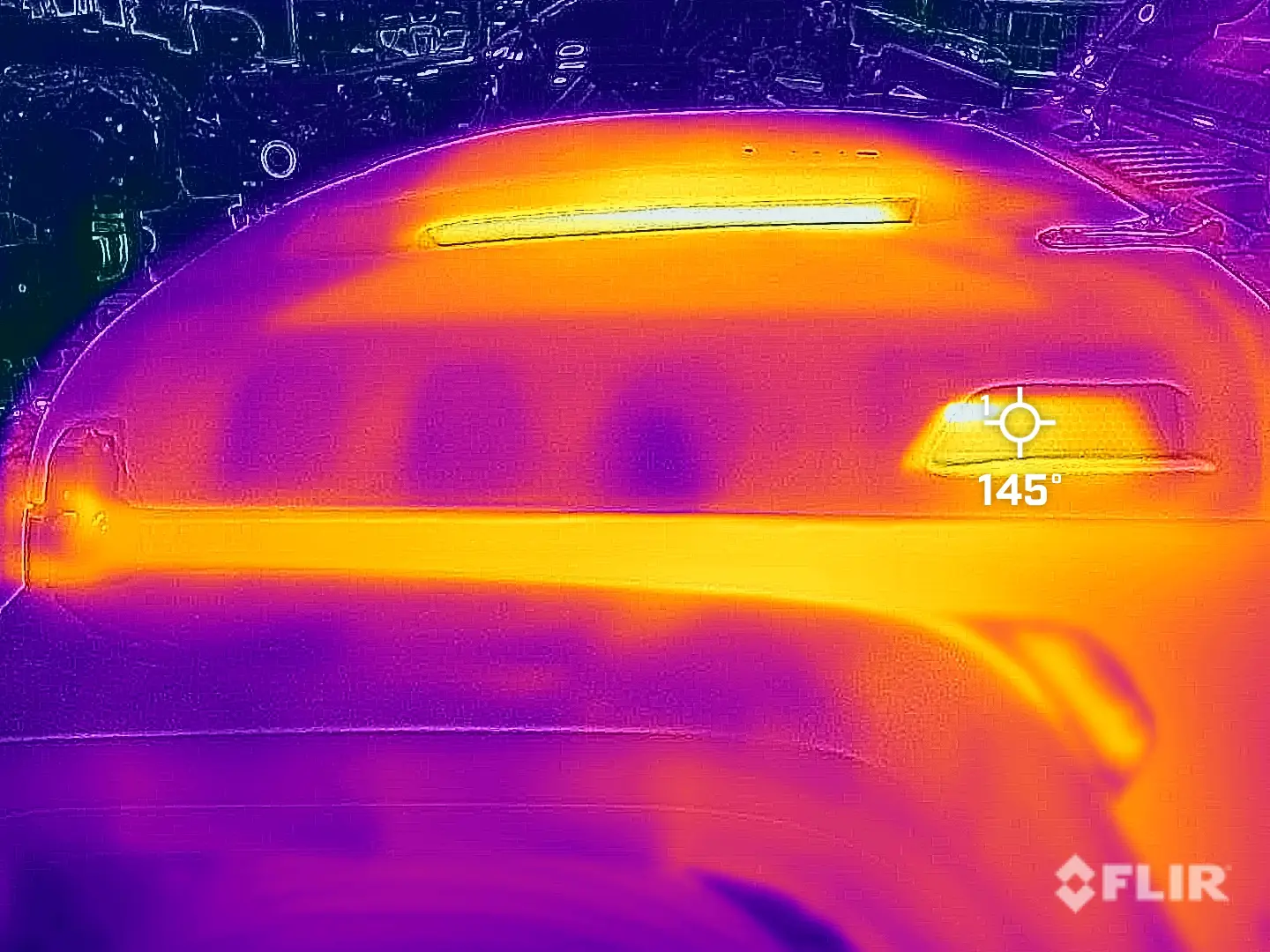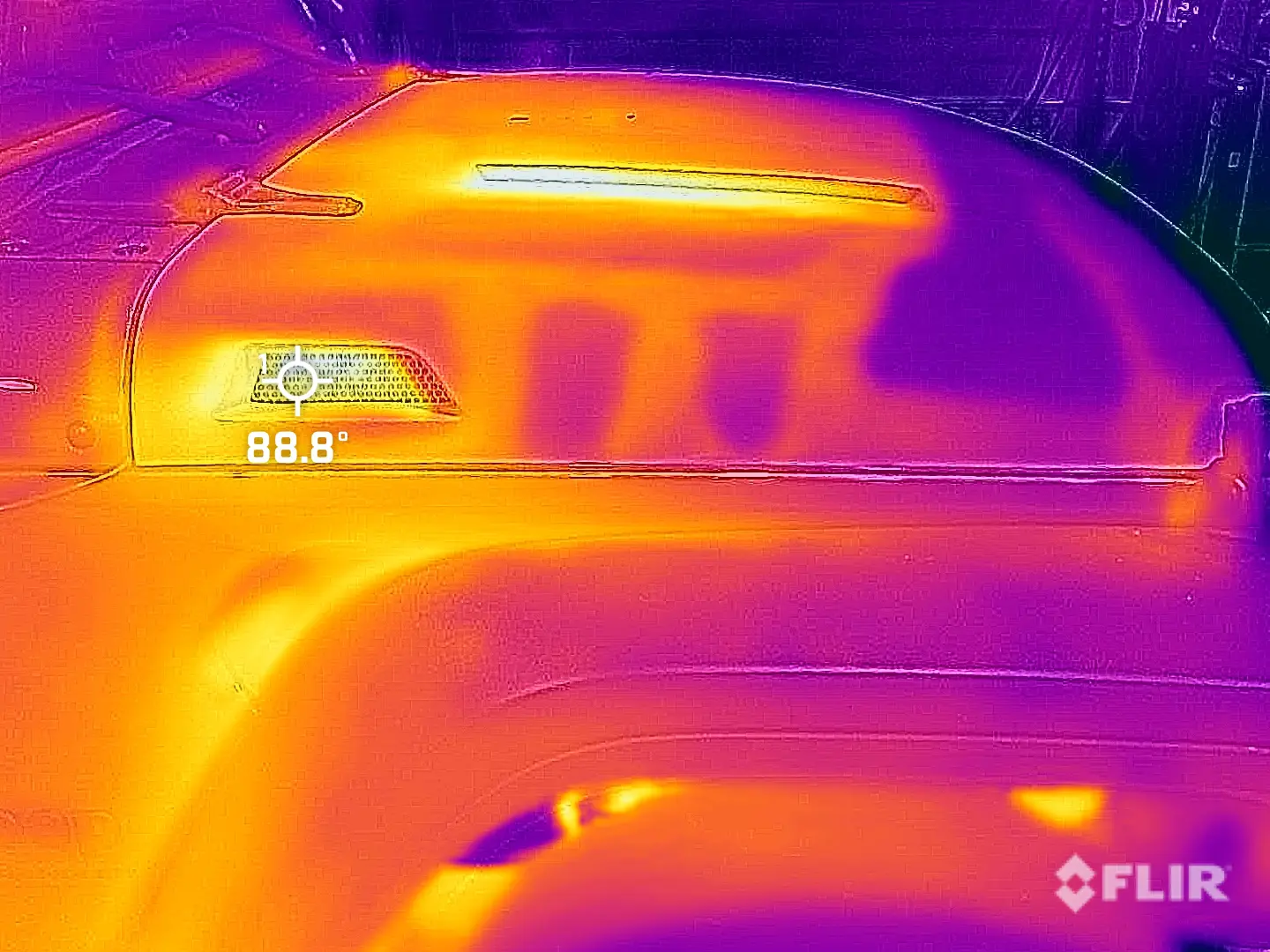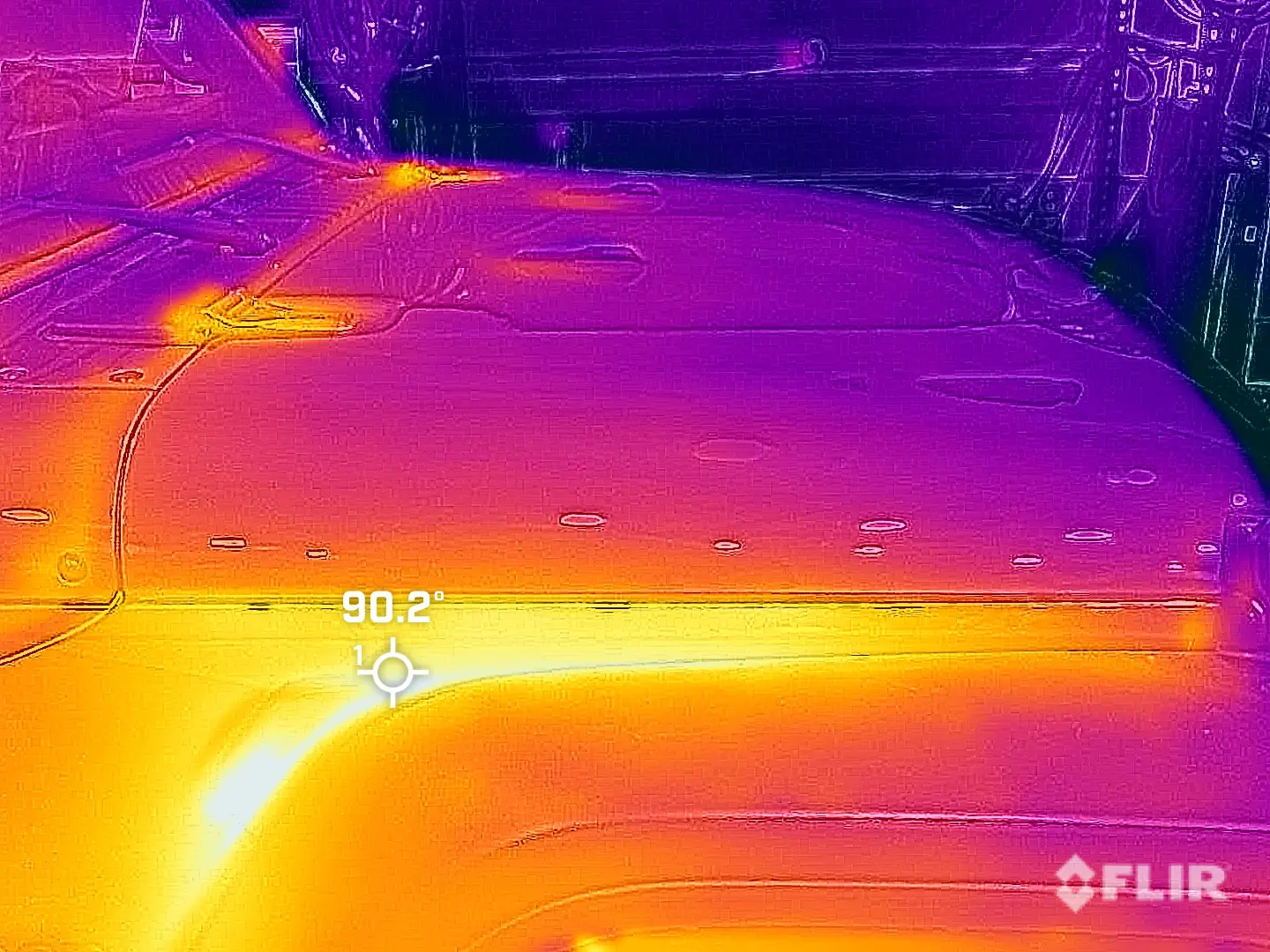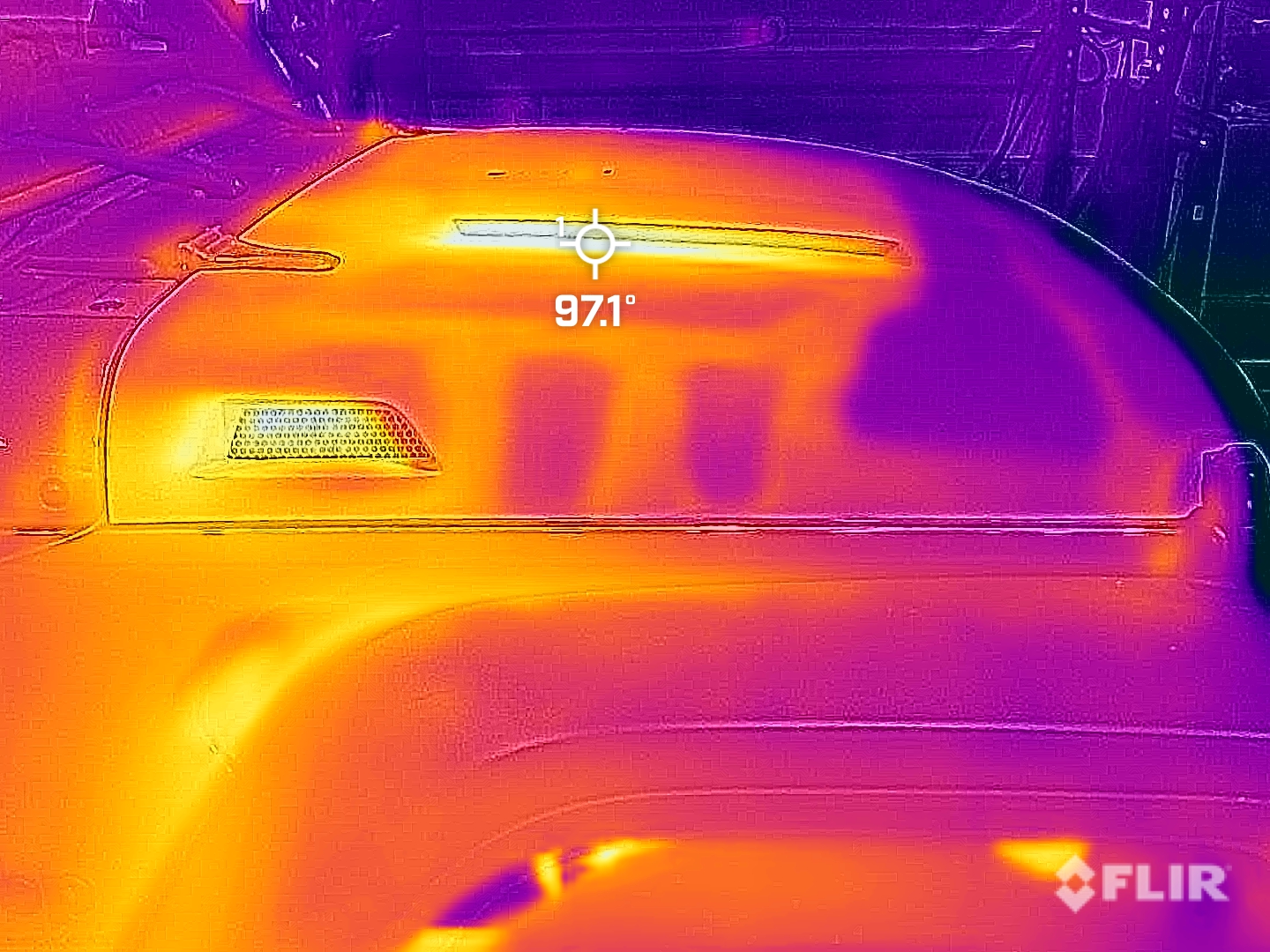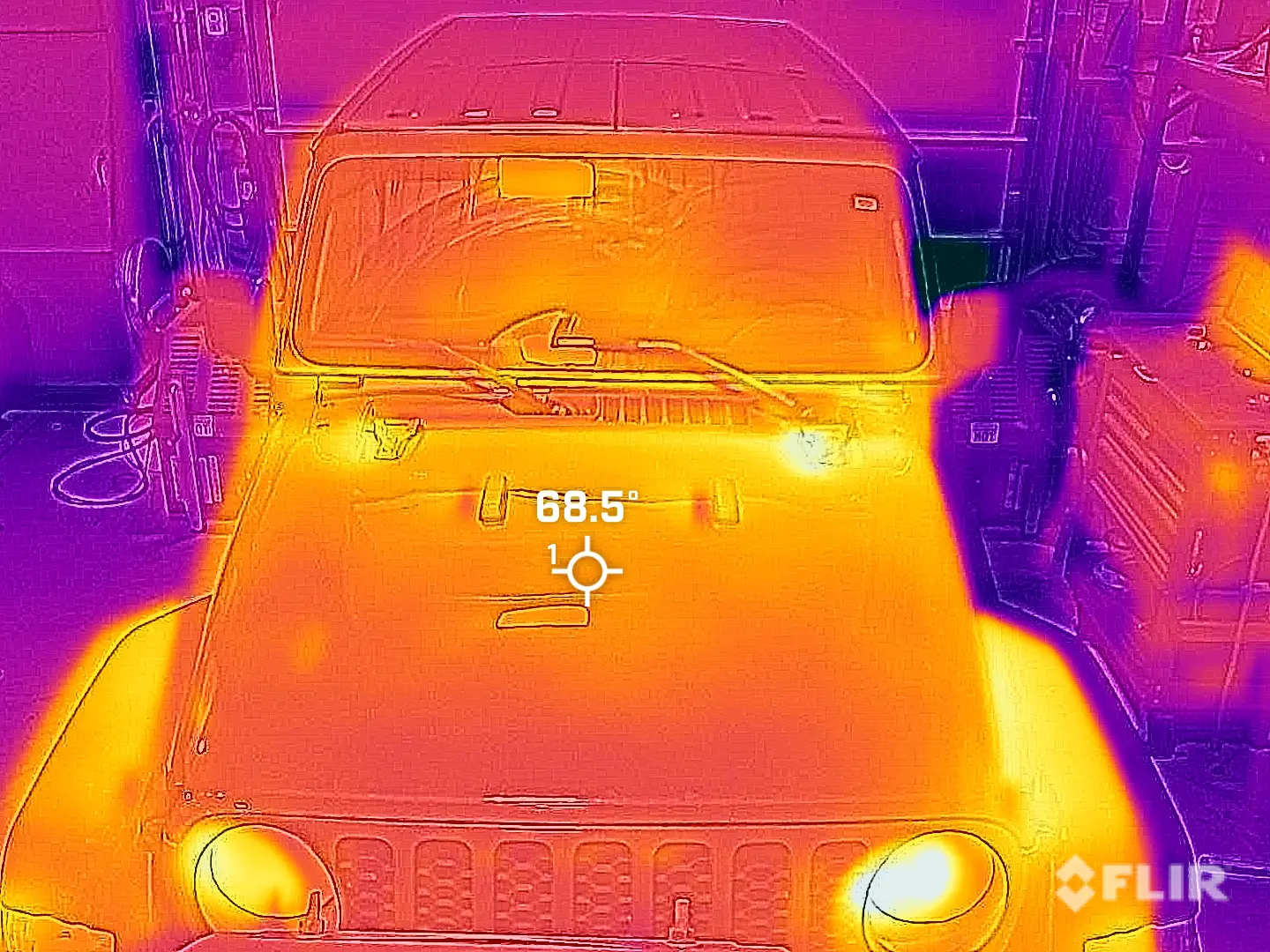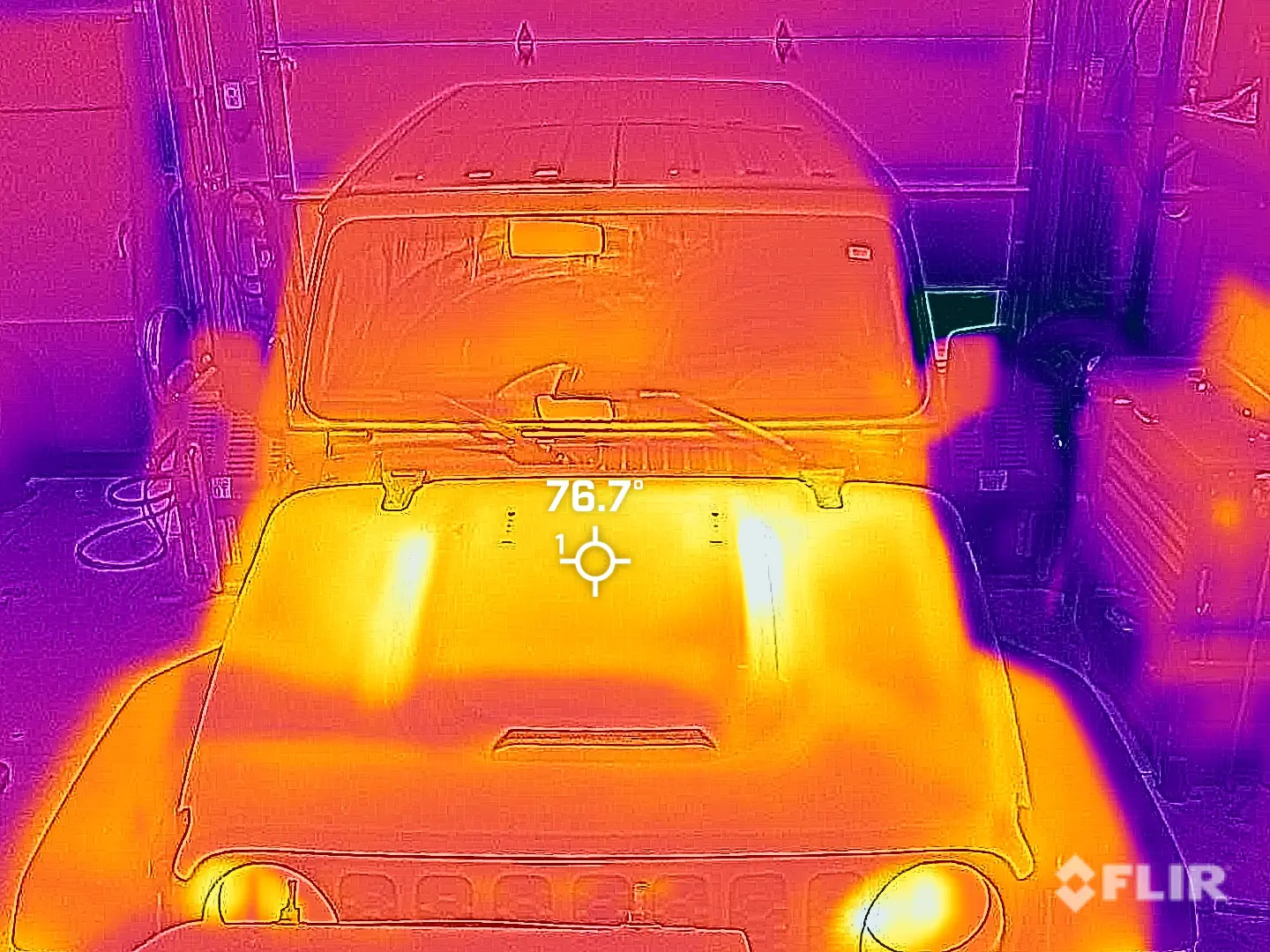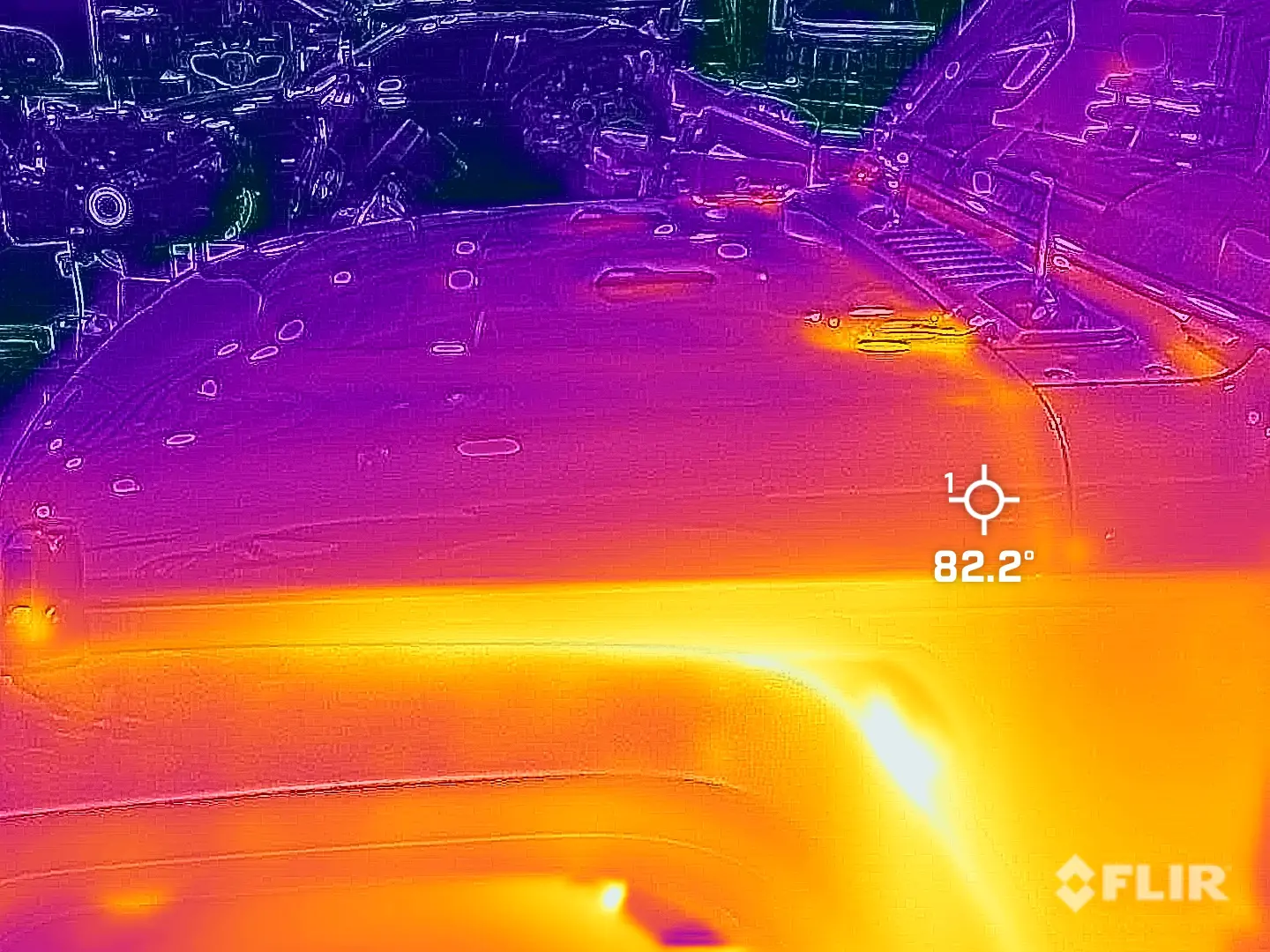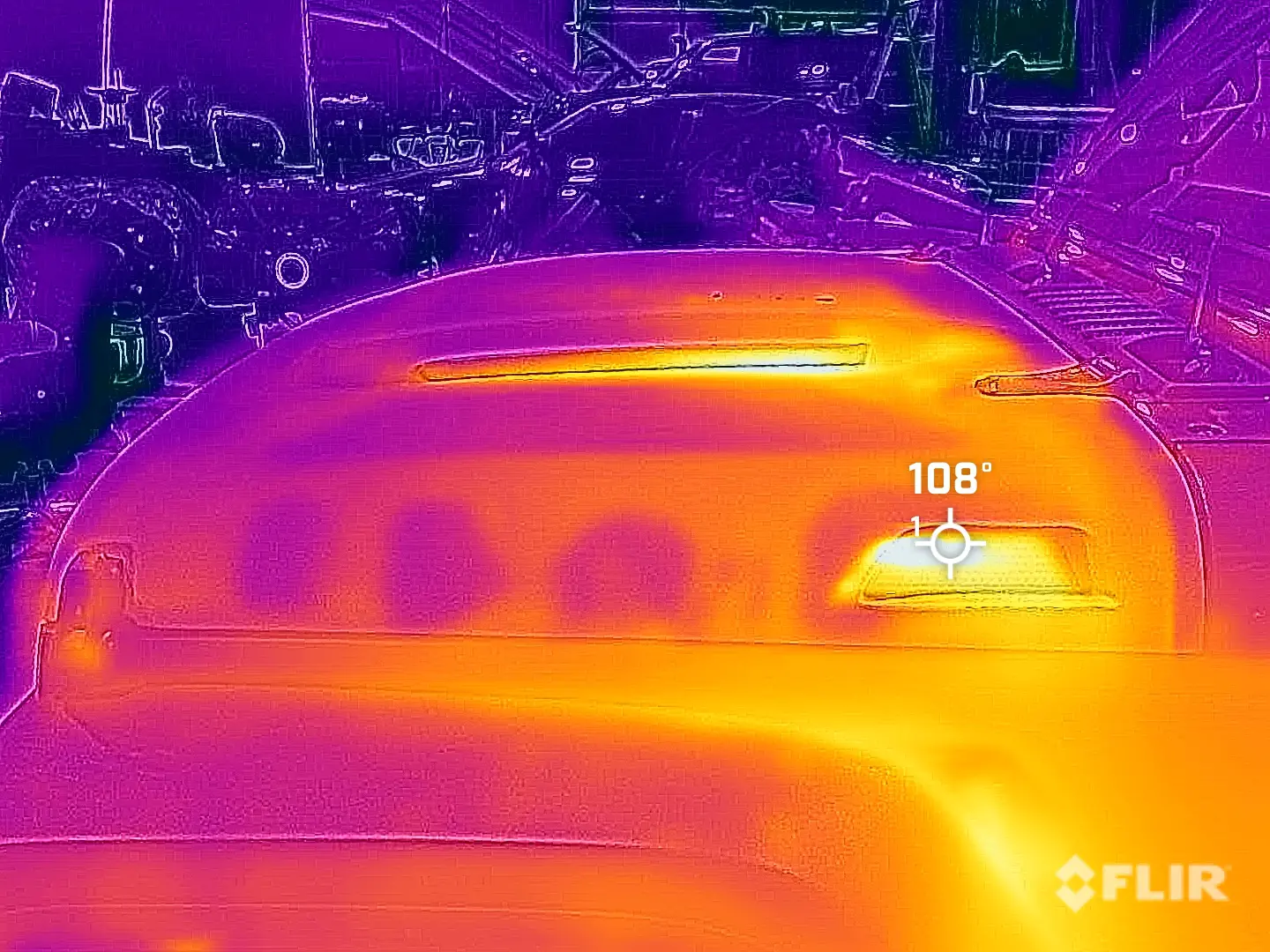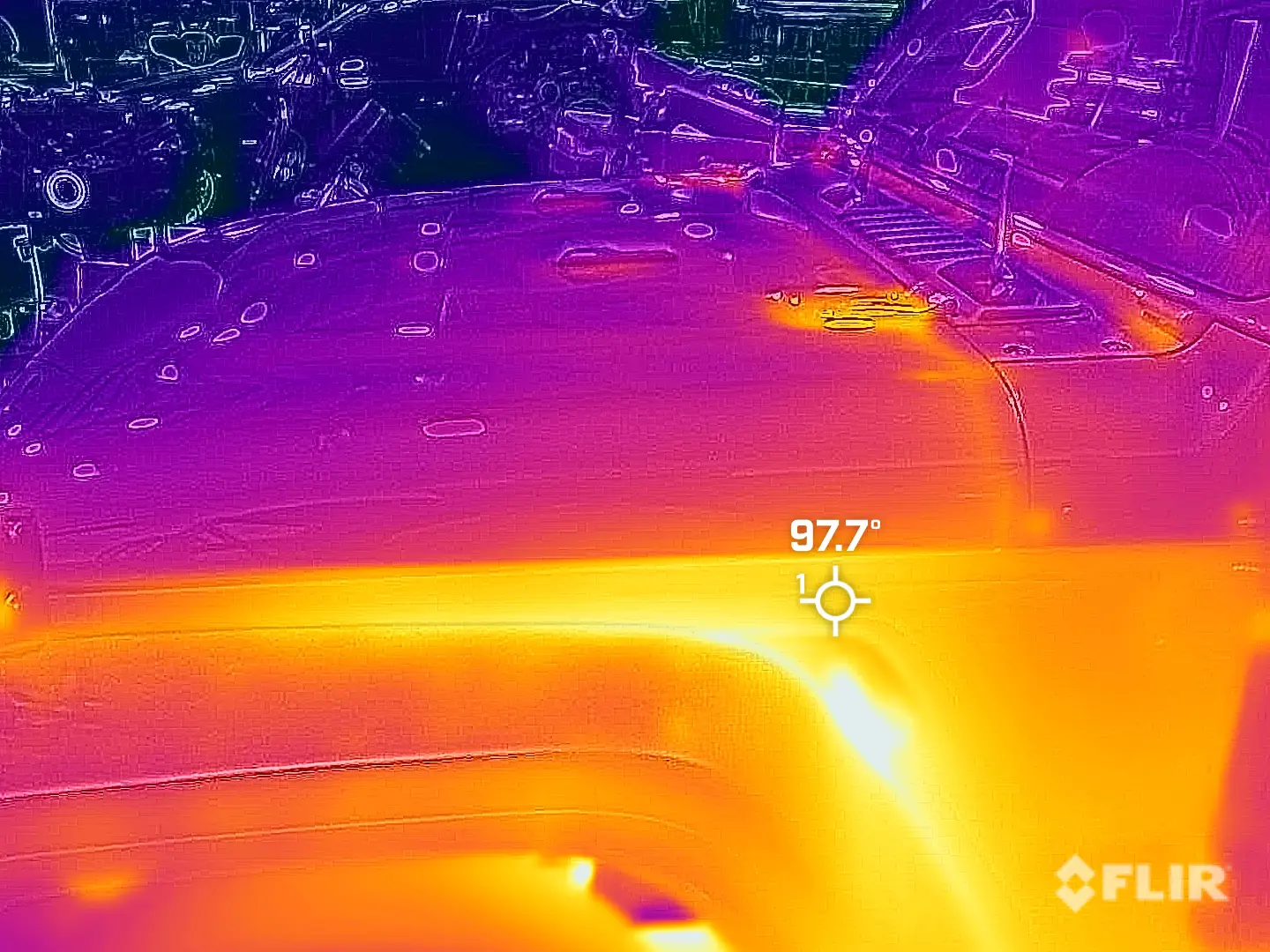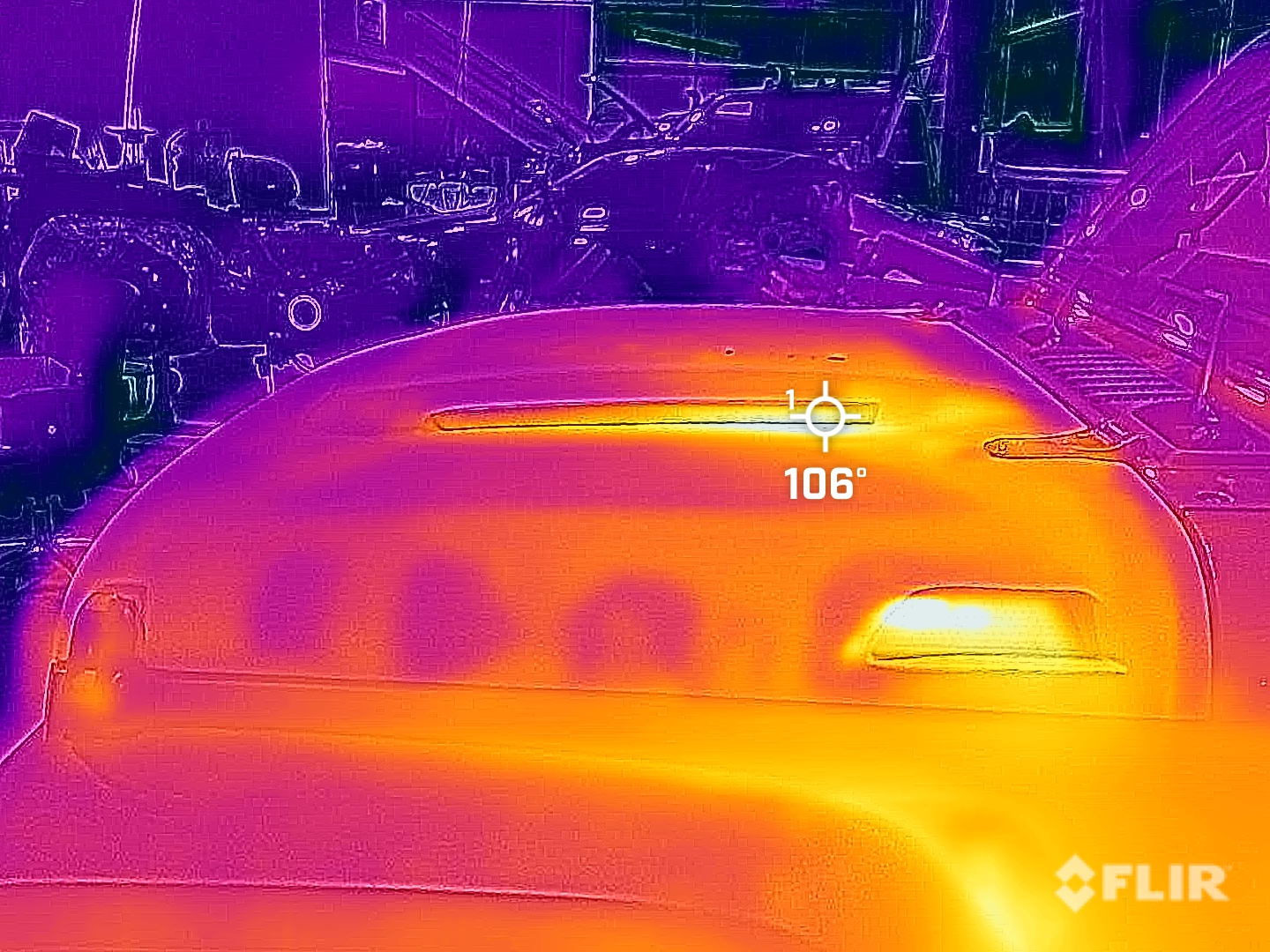Testing Summary
This page contains a lot of information and images to describe how we tested our JL/JT H.E.R.O. Hood to demonstrate how it will help your Jeep perform better. For those that just want to know the results, here they are:
- Average 25+ degree drop in engine bay temperatures at slow speeds
- Average 20+ degree drop in intake air temperatures at slow speeds
- Average 18+ degree drop in engine bay temperatures at cruising speeds
- Average 15+ degree drop in intake air temperatures at cruising speeds
Disclaimer: These are the results of our testing. Results will vary depending on the conditions your Jeep is experiencing.
Test Equipment
For these tests, we loaded a bone stock 2024 Jeep Wrangler 2.0 turbo 4 cylinder on a load bearing hub dyno made by DYNOmite. By doing so, we were able to conduct all the tests in a controlled environment and were able to load the Jeep (provide resistance at the axles) to stimulate real world driving. The dyno has its own built in weather station to describe ambient conditions:
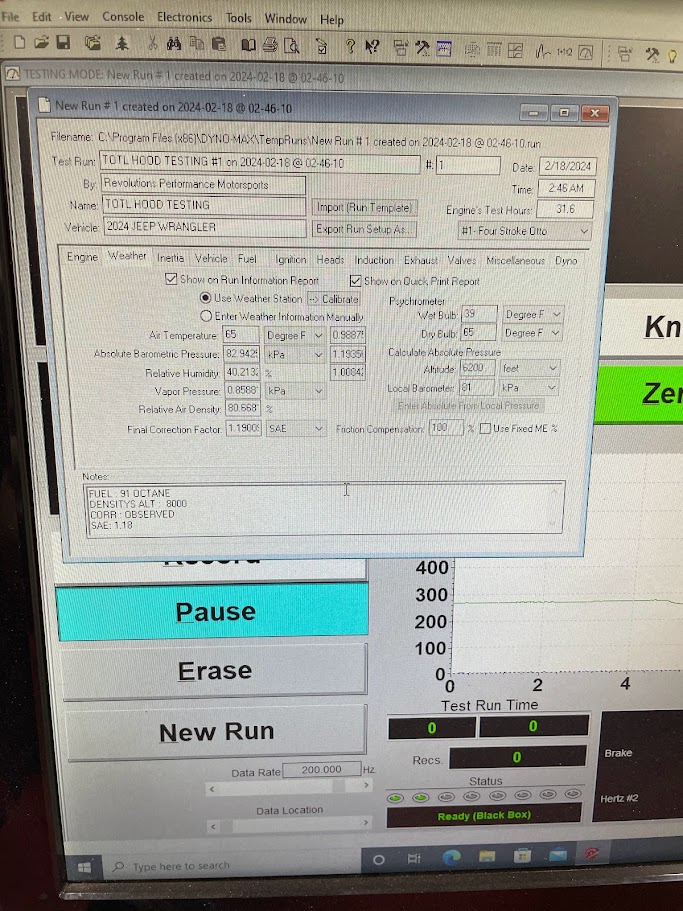
To take readings, we turned to Banks Engineering who we consider to be at the pinnacle of the aftermarket industry. They use their own products for internal testing so we followed suite. We ordered their Banks Data Monster and coupled it with 3 separate temperature sensors that we strategically placed throughout the engine bay. We wanted to sample an average engine bay temperature as well as temperatures at critical electrical components.

The first temperature sensor was placed close to the fuse box located by the passenger side firewall

The second temperature sensor was placed on top of the engine cover and was spaced away from the surface using a foam pad. This was meant to give us an average engine bay temperature reading.
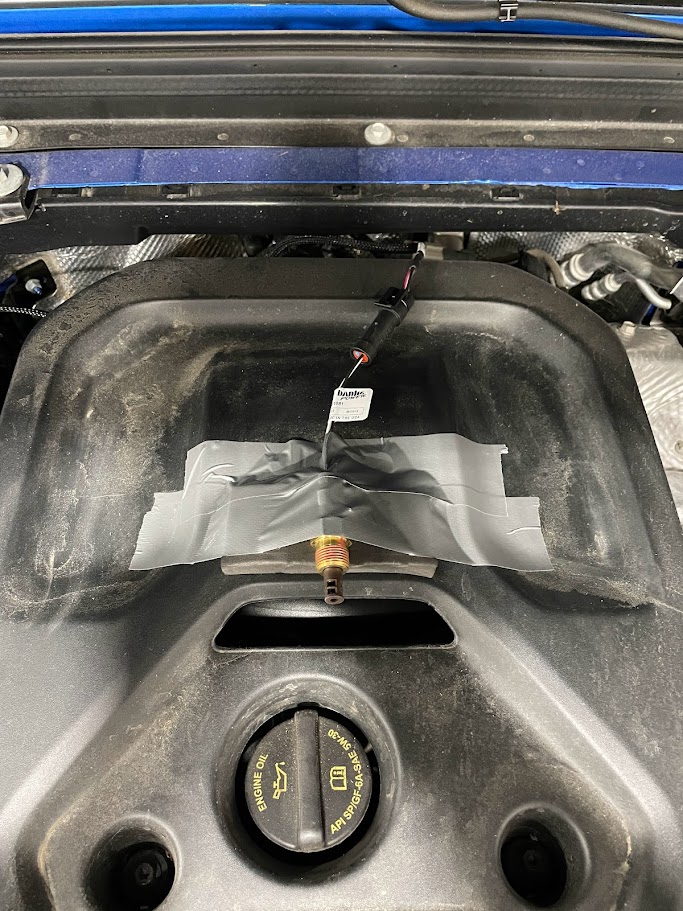
The last temperature sensor was placed by the factory ECU on the driver’s side
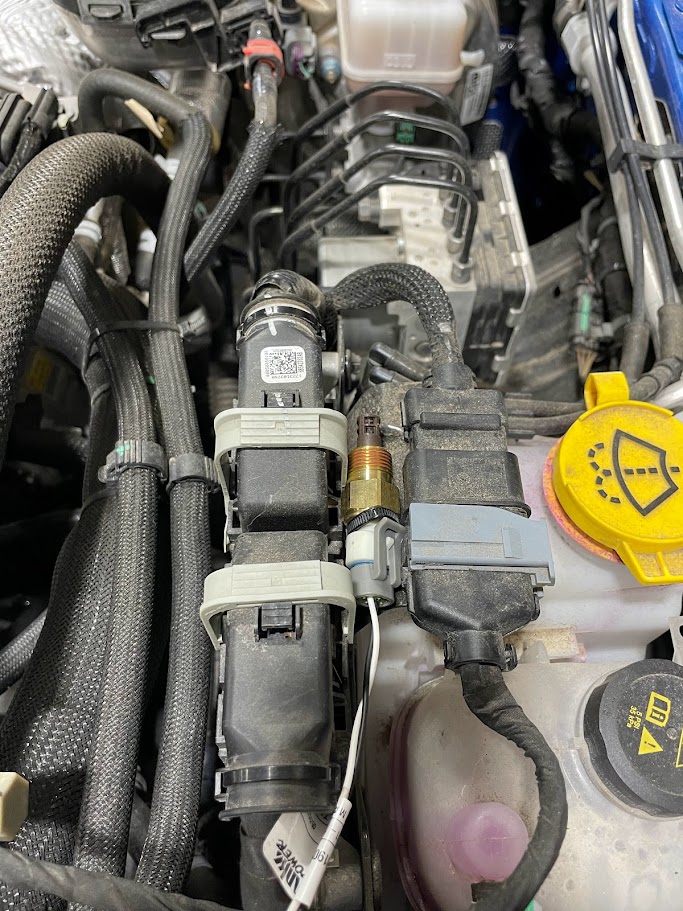
In addition to the 3 temperature sensors, we also mounted a Banks Air Mouse inside the factory air box. The Air Mouse is an extremely powerful sensor that acts like a weather station allowing us to measure multiple conditions inside the air box.
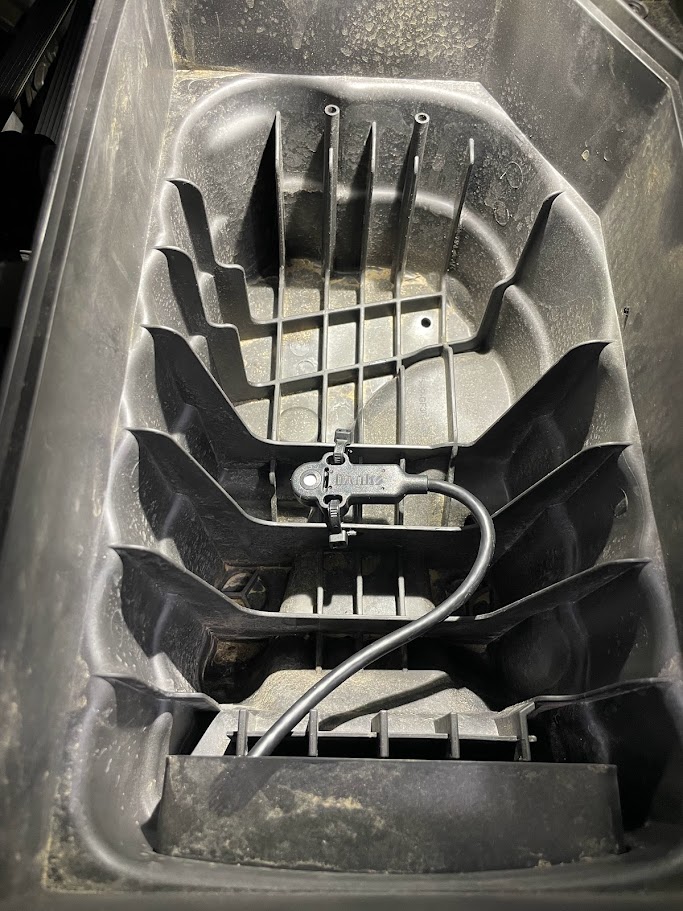
For thermal imagery, we used a FLIR One PRO. Thermal imagery was taken immediately after each log was stopped and this allowed us to capture some amazing information. Lastly we used an Amazon bought Anemometer to measure the wind speed of our dyno fan to determine the speed for our driving test.
Test Setup
To begin each test, we let the Jeep idle until we noticed all 3 of our temperature sensors had reached a consistent temperature. At the point, we considered the engine bay to be at its saturated operating temperature and an equal starting point for each test. We would like to note that we monitored coolant and oil temperatures at the same time and couldn’t use them as a reference for starting each test because they reached their specified operating temperatures well before the engine bay temperatures.
Once temperatures were reached, the test started and we logged each one for approximately one minute. Once a test was complete, we waited for temperatures to reach the same baselines previously established before moving on to the next test.
For the speed test described below, we measured that the wind speed at the front of grille was 35 mph when the dyno fan was roughly 25” away from the Jeep so we decided to run these tests at that speed to try to simulate as close to real world as we could.
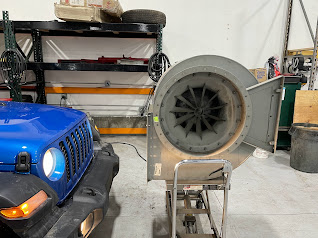
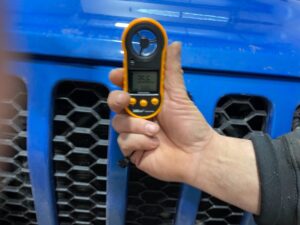
Idle Test
The first test we wanted to perform was a Jeep sitting at idle. We wanted to see what is happening in the engine bay without any sort of external factors so the dyno fan was not running. This would be similar to a real world traffic at a stand still type of scenario. We also wanted to measure the impact that any hood would have on the engine bay so for this round of testing, we actually tested the factory hood, our H.E.R.O. Hood and one additional test where the hood was rested over on the windshield. This would give us a floor of the best conditions possible had nothing been covering the engine bay at all. This was the only test where we tested with the hood completely removed from the equation. All other tests were the factory hood vs. our H.E.R.O. Hood
Looking at the summarized averages of the three tests below, you can see that there is roughly a 60 degree difference across the three temperature sensors between having no hood and running the factory hood but look at how much heat is able to escape the engine bay through our two stage vent design. Switching over to our H.E.R.O. Hood netted an average 26 degree drop across the three sensors.
| Open Hood | Factory | TOTL | Difference | |||
|---|---|---|---|---|---|---|
| Fuse Box Temp (°F) | 122.00 | 187.27 | 163.88 | 23.39 | ||
| Center Engine Bay Temp (°F) | 149.99 | 210.03 | 184.63 | 25.40 | ||
| ECU Temp (°F) | 115.31 | 187.86 | 159.26 | 28.59 |
What really surprised us on this test is what was happening inside the air box once we got all this heat out of the engine bay. The air temperature going into the motor also dropped by 25 degrees as measured by both the Air Mouse (Ambient Air Temp) located in the air box and the factory ECU (Intake Air Temp) resulting in a slightly better ambient air density. For those interested in reading why we are focused on air density, Banks has a pretty detailed explanation:
| Open Hood | Factory | TOTL | Difference | |||
|---|---|---|---|---|---|---|
| Ambient Air Temp (°F) | 115.28 | 144.46 | 119.26 | 25.20 | ||
| Intake Air Temp (°F) | 105.25 | 156.20 | 131.18 | 25.02 | ||
| Density Ambient Air (LB/1kFT³) | 54.47 | 51.86 | 54.01 | (2.15) Increase |
Below are the thermal images taken during this test. It gives you a pretty good idea of how much heat is escaping from the vents on our H.E.R.O. Hood.
Crawl Test
The purpose of this test was to try to simulate what is happening when you are out wheeling your Jeep. We ran the Jeep at 10 mph without the dyno fan running to simulate a slow crawl with little to no airflow to help the factory cooling system. This is similar to the previous test but everything is under increased strain because the Jeep is running under load without any sort of external cooling.
Our H.E.R.O. Hood resulted in an average 31 degree drop measured across the 3 temperature sensors
| Factory | TOTL | Difference | |||
|---|---|---|---|---|---|
| Fuse Box Temp (°F) | 194.13 | 163.38 | 30.75 | ||
| Center Engine Bay Temp (°F) | 214.94 | 184.16 | 30.78 | ||
| ECU Temp (°F) | 195.97 | 162.65 | 33.32 |
As a result of the decreased engine bay temperatures, we again saw a benefit with air intake temperatures dropping 18+ degrees resulting in denser ambient air
| Factory | TOTL | Difference | |||
|---|---|---|---|---|---|
| Ambient Air Temp (°F) | 151.93 | 133.70 | 18.23 | ||
| Intake Air Temp (°F) | 163.40 | 142.15 | 21.25 | ||
| Density Ambient Air (LB/1kFT³) | 51.35 | 52.82 | (1.47) Increase |
The thermal images from this test were very similar to the idle test but you can see that temperatures have increased.
Cruising Speed Test
The purpose of this test was to simulate what happens when you are out driving on the street. Even with 35 mph, the H.E.R.O. Hood continues to deliver a reduction in under hood temperatures
| Factory | TOTL | Difference | |||
|---|---|---|---|---|---|
| Fuse Box Temp (°F) | 169.17 | 151.48 | 17.69 | ||
| Center Engine Bay Temp (°F) | 178.01 | 164.31 | 13.70 | ||
| ECU Temp (°F) | 160.39 | 137.17 | 23.22 |
For intake air temperature and performance, we unfortunately encountered an issue. We did email Banks with our logs to confirm our suspicion that the test using our H.E.R.O. Hood began with a heat soaked Air Mouse. The factory hood test started with a 126 Ambient air temperature while the same test with our H.E.R.O. Hood started out at 143 degrees. Had the test started properly, the Air Mouse reading would have been in line with the factory air temperature readings just as it has been for all the other tests. We would then have been able to provide a correct increase in Ambient Air Density. None the less, you can still see a 15+ degree reduction in air temperature compared to stock.
| Factory | TOTL | Difference | |||
|---|---|---|---|---|---|
| Intake Air Temp (°F) | 139.36 | 123.41 | 15.96 |
If a picture is truly worth a thousand words, then of all the tests, I think the thermal images from this last test tell the most. In particular, you can actually see the cold ram air in action represented by the blue section going from the air scoop directly to the factory air box pre chamber. How cool (pun intended) is that?
